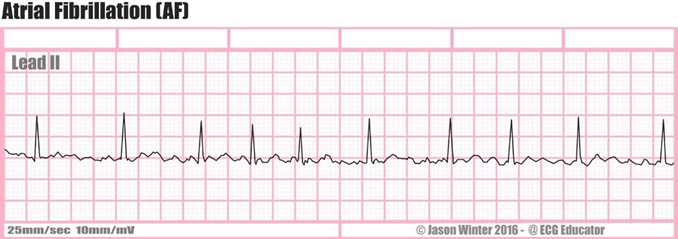A nurse is assessing a client who has atrial fibrillation. Which of the following pulse characteristics should the nurse expect?
Irregular
Bounding
Not palpable
Slow
The Correct Answer is A
A In atrial fibrillation (AF), the electrical activity in the atria is chaotic, leading to an irregularly irregular ventricular response. As a result, the pulse felt at the radial artery will be irregular, with no discernible pattern. The irregularity is a hallmark feature of AF and is often described as "irregularly irregular."
B Bounding pulses are characterized by a strong and forceful pulsation felt at the arterial pulse sites. In atrial fibrillation, the irregular and rapid ventricular response can lead to an increased stroke volume and forceful contraction of the left ventricle during diastole, resulting in bounding pulses. However, bounding pulses are not typically associated with atrial fibrillation; they are more commonly seen in conditions such as aortic regurgitation or hyperdynamic circulation.
C In some cases of atrial fibrillation, especially if the ventricular rate is very rapid or irregularly irregular, the pulse may not be palpable due to the inconsistent ventricular contractions.
However, in most cases of atrial fibrillation, a pulse is palpable, albeit irregular.
D Atrial fibrillation can result in a rapid ventricular response, leading to a fast heart rate. However, the pulse rate can vary widely among individuals with atrial fibrillation. While some may have a rapid heart rate (tachycardia), others may have a slower heart rate (bradycardia), depending on factors such as concomitant medications, autonomic tone, and the presence of underlying heart disease.
Nursing Test Bank
Naxlex Comprehensive Predictor Exams
Related Questions
Correct Answer is D
Explanation
D. Oral hygiene is crucial in reducing the risk of VAP as it helps to reduce the bacterial load in the oral cavity, which can be aspirated into the lower respiratory tract. Using a suction toothbrush to mechanically remove dental plaque and bacteria from the teeth and oral mucosa can help to prevent VAP.
A. Elevating the head of the bed to between 30 and 45 degrees (semi-recumbent position) is recommended to prevent aspiration of oral or gastric contents, which can contribute to the development of VAP. This position helps to promote drainage of secretions and reduces the risk of reflux.
B. While maintaining appropriate humidity levels in the ventilator tubing helps to prevent drying of the respiratory mucosa and promote secretion clearance, it does not directly reduce the risk of VAP. Other interventions are more directly related to VAP prevention.
C. Regular turning and repositioning of the client help to prevent pooling of secretions, improve ventilation-perfusion matching, and reduce the risk of pressure ulcers. Turning the client every 2 hours is often recommended to optimize lung expansion and secretion clearance, thereby reducing the risk of VAP.
Correct Answer is C
Explanation
C Atrial fibrillation (AF) is characterized by rapid, irregular electrical activity in the atria, leading to an irregularly irregular ventricular response. AF often results in palpitations, fatigue, and dizziness due to the irregular heart rhythm and inefficient cardiac output. A significant pulse deficit may also be present due to the irregularity of the ventricular response compared to the atrial activity. Given the sudden onset of irregular palpitations, fatigue, dizziness, and a significant pulse deficit, atrial fibrillation is a likely dysrhythmia in this scenario.

A First-degree AV block is characterized by a prolonged PR interval on the electrocardiogram (ECG), indicating delayed conduction between the atria and ventricles. While it can indicate conduction system abnormalities, it typically does not result in rapid or irregular palpitations, fatigue, or dizziness.
Therefore, it is less likely to be the cause of the client's symptoms.
B Sinus tachycardia is characterized by a rapid heart rate originating from the sinus node, typically with a regular rhythm. While sinus tachycardia can cause palpitations and fatigue, it is less likely to result in an irregular heart rate with a significant pulse deficit. Therefore, it is less likely to be the cause of the client's symptoms.
D Sinus bradycardia is characterized by a slow heart rate originating from the sinus node. While sinus bradycardia can cause fatigue and dizziness, it typically does not result in a rapid or irregular heart rate. Therefore, it is less likely to be the cause of the client's symptoms.
Whether you are a student looking to ace your exams or a practicing nurse seeking to enhance your expertise , our nursing education contents will empower you with the confidence and competence to make a difference in the lives of patients and become a respected leader in the healthcare field.
Visit Naxlex, invest in your future and unlock endless possibilities with our unparalleled nursing education contents today
Report Wrong Answer on the Current Question
Do you disagree with the answer? If yes, what is your expected answer? Explain.
Kindly be descriptive with the issue you are facing.
